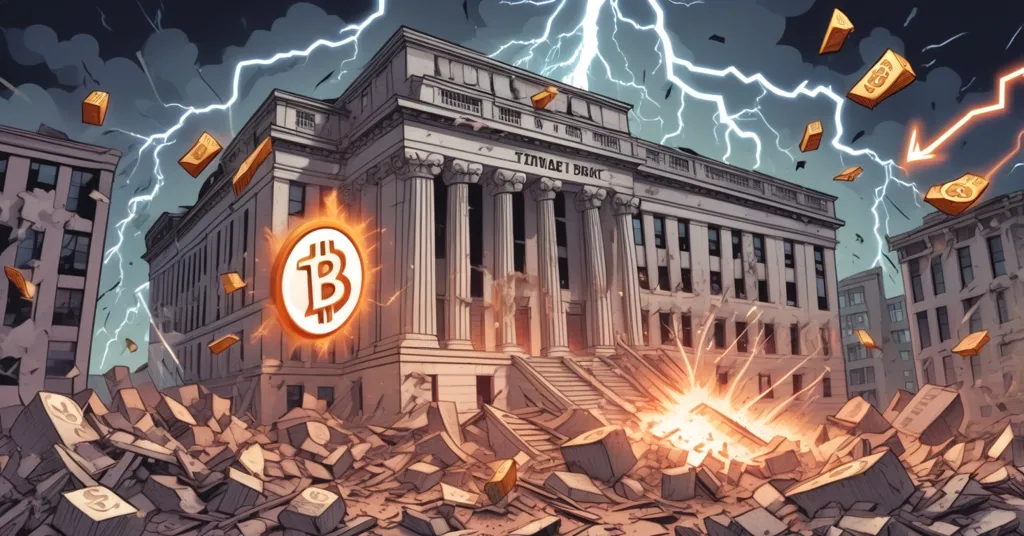Trump’s Feud with Powell and Tariffs Fuel Bitcoin’s Decentralization Argument

Trump’s War on Powell and Global Trade: A Centralized Mess Fueling Bitcoin’s Case
President Donald Trump’s escalating feud with Federal Reserve Chairman Jerome Powell over high interest rates, paired with a barrage of punishing tariffs on global trade partners, is shaking the financial world to its core. This dual assault on monetary and trade fronts is brewing a storm of uncertainty, potentially exposing the fragility of centralized systems and amplifying the argument for decentralized alternatives like Bitcoin.
- Monetary Clash: Trump slams Powell for high interest rates, claiming they’re strangling US economic growth and costing billions.
- Tariff Onslaught: New tariffs target Canada, EU, Mexico, and Brazil, with a brutal 50% hit on Brazilian goods and copper imports, effective August 1.
- Power Grab: White House floats firing Powell for cause, while eyeing a $2.5 billion Fed headquarters renovation as potential leverage.
Trump vs. Powell: A Centralized Showdown
The tension between Trump and Powell has been simmering for years, but it’s now hitting a fever pitch. Trump has repeatedly bashed the Fed Chairman, arguing that high interest rates are kneecapping the US economy and blocking its path to global dominance. “Interest rates should be three points lower,” Trump has insisted, a refrain that underscores his frustration with the Fed’s cautious stance. For the uninitiated, the Federal Reserve is the US central bank, tasked with setting benchmark interest rates that ripple through the economy. Think of these rates as a brake pedal—higher rates slow growth to prevent overheating (inflation), while lower rates can rev things up but risk losing control. Powell’s insistence on keeping rates elevated to manage inflation is, in Trump’s view, costing the nation billions and stifling potential, as detailed in recent coverage of this ongoing conflict.
But Trump isn’t stopping at words. White House economic adviser Kevin Hassett dropped a nuclear option on ABC News, suggesting the president could axe Powell if there’s justifiable cause.
“If there is cause—such as misconduct or dereliction of duty—the president has the authority to dismiss Powell,” Hassett declared.
This isn’t just saber-rattling; it’s a direct threat to the Fed’s independence, a cornerstone of US economic policy since 1913 meant to shield monetary decisions from political whims. No modern president has dared fire a Fed Chairman, and the mere suggestion is enough to rattle markets. For deeper insight into whether this is even feasible, there’s expert analysis on the legalities of such a move. For crypto advocates, this is a glaring red flag. If a centralized institution like the Fed can be bent to political will, doesn’t that scream for systems like Bitcoin—where no single authority calls the shots, immune to such interference?
To twist the knife, the administration is zeroing in on a $2.5 billion renovation of the Fed’s headquarters in Washington, the most expensive federal project in the city’s history. Hassett didn’t hold back on the implications of the Fed’s unchecked budget autonomy.
“The Fed could print money and toss it around willy-nilly… and they’re unbounded right now,” Hassett remarked.
A $2.5 billion facelift? That’s enough to buy a small fleet of Bitcoin at 2011 prices. Whether this is genuine concern over fiscal waste or a convenient cudgel to bash Powell, it highlights a burning question: who truly controls the levers of US finance, and at what cost to stability? If trust in these centralized gatekeepers erodes, alternatives like Bitcoin—built on transparency and a fixed supply—start looking less like a niche experiment and more like a necessity, especially as a hedge against financial instability.
Tariff Chaos: Economic Fallout and Crypto Angles
While Trump spars with the Fed at home, he’s picking fights abroad with a fresh wave of tariffs effective August 1, slamming imports from Canada, the European Union, Mexico, and Brazil. The harshest blow? A staggering 50% tariff on Brazilian goods, widely seen as a petty jab tied to Trump’s irritation over Brazil’s legal pursuit of former President Jair Bolsonaro, a close ally. Hassett framed this as strategic, not spiteful.
“This is part of an overall strategy to onshore production in the US,” Hassett argued, adding, “Right now, we’ve got that guy who wrote The Art of the Deal making deals for the American people. He sent these letters out to folks to put a line in the sand.”
Yet the scoreboard tells a different story. Formal trade agreements have only been inked with the UK and Vietnam, plus a shaky partial framework with China. This hardball tactic is more chaos than cunning, risking retaliatory trade wars while US businesses foot the bill. Let’s call it what it is: a half-baked power play that’s more about ego than economics, with broader context available on Trump’s economic policies via historical records.
Then there’s the 50% tariff on copper imports, a gut punch to industries reliant on this metal. Copper isn’t just a commodity; it’s the backbone of tech and manufacturing, wiring everything from smartphones to military gear. For the crypto crowd, it’s also a silent player in blockchain infrastructure—think Bitcoin mining rigs and data centers packed with copper components. Hiking costs here could squeeze miners’ already thin margins, especially amid volatile energy prices. The Wall Street Journal reports and business leaders have slammed the move for inflating costs for US manufacturers of aircraft, electronics, and ammunition. Hassett countered with a national security angle.
“Copper is a key component in many American weapon sets. We have plenty of copper in the US, but not enough copper production,” he insisted.
Sure, securing domestic supply for emergencies makes sense, but screwing over manufacturers in the meantime isn’t the answer. This exposes the creaking inefficiencies of global supply chains—precisely where blockchain tech could shine. Platforms like IBM’s TradeLens or Ethereum-based systems using smart contracts (code that automates agreements without middlemen) can slash costs and fraud in cross-border trade. Projects like VeChain and OriginTrail are already proving how tokenized trade—turning physical goods into trackable digital assets on a blockchain—cuts through political nonsense like tariffs. Why wield a sledgehammer when precision tools exist? For miners feeling the pinch, community discussions on tariff impacts offer real-world insights.
Decentralization’s Moment: Bitcoin’s Case Grows
Zooming out, Trump’s one-two punch of Fed meddling and trade wars is a neon sign flashing the flaws of centralized systems. If the president can threaten a central bank leader over policy disagreements, what’s stopping broader overreach? Historically, political pressure on the Fed—like Nixon’s in the 1970s—fueled disasters such as runaway inflation. Bitcoiners have long warned this could repeat, especially if trust in the US dollar as the world’s reserve currency starts to wobble. During Trump’s initial trade war with China in 2018, Bitcoin spiked 20% in three months as investors fled fiat uncertainty, per CoinDesk data. We could see similar moves now if dollar confidence slips further, with some exploring how Fed policies intersect with crypto.
But beware of grifters hyping ‘guaranteed’ BTC pumps off this news—price moves are unpredictable, and shills prey on hype. Still, the logic holds: Bitcoin’s finite supply of 21 million coins shields it from the inflationary games central banks play. Unlike fiat, where the Fed can “print money willy-nilly,” as Hassett put it, Bitcoin operates on a network with no single controller. It’s financial sovereignty in code form, a hedge against the chaos of centralized meddling.
Trade disputes also spotlight blockchain’s broader potential. Tariffs and retaliatory policies inflate costs and delay goods, but decentralized ledgers offer transparency and speed. Imagine global trade where every shipment is verified on-chain, bypassing bureaucratic red tape or political vendettas. Ethereum’s smart contracts could rewrite the rules, cutting through tariff nonsense with immutable agreements. This isn’t sci-fi; it’s already happening in pilot projects across logistics. Centralized systems are cracking under Trump’s policies—blockchain could be the glue that holds the future together.
Playing Devil’s Advocate: Is Chaos the Catalyst?
Let’s flip the script for a moment. Could Trump’s wrecking ball approach, reckless as it seems, unintentionally speed us toward a decentralized future? If we buy into effective accelerationism—the idea that pushing systems to their breaking point hastens transformative change—then this chaos might be a bitter but necessary pill. High interest rates do choke innovation, something crypto startups feel when capital dries up. Tariffs, for all their collateral damage, aim for domestic resilience, not unlike the self-sovereignty ethos of Bitcoiners who want to cut reliance on fragile global systems. For a broader look at the stakes of this monetary feud with Powell, the economic implications are still unfolding.
But execution matters, and this is a messy gamble. Bitcoin can’t fix a manufacturing crisis overnight, and regulatory uncertainty remains a sword over crypto’s head. If Trump’s antics tank the dollar’s credibility, regulators might scapegoat decentralized assets with harsher laws, as seen with the 2021 infrastructure bill’s crypto tax debacle. Plus, not every centralized failure translates to crypto gains—scaling issues and adoption hurdles still loom large. Is this chaos a disaster waiting to unfold, or a painful but necessary push toward financial freedom? The jury’s out, but the stakes couldn’t be higher.
Key Takeaways and Questions Answered
- What’s behind Trump’s feud with Powell?
Trump accuses Powell of crippling US growth with high interest rates, costing billions, while Powell maintains rates to curb inflation—a classic centralized policy clash. - Can Trump actually fire the Fed Chairman?
Legally, yes, if there’s “cause” like misconduct, per adviser Kevin Hassett, though it’s a radical move that could shatter market trust in the dollar and boost Bitcoin’s appeal. - Why slap tariffs on allies like Canada and Brazil?
Trump aims to force better trade deals and boost domestic production, but with few agreements secured, it risks trade wars and higher costs for US firms, exposing supply chain flaws blockchain could address. - How do tariffs on copper impact Bitcoin mining?
Copper is vital for mining hardware; a 50% tariff hikes costs, squeezing miners’ profits and potentially slowing Bitcoin network growth amid other economic pressures. - Why does Fed independence matter for cryptocurrency?
If political interference undermines the Fed, trust in fiat could falter, driving interest in Bitcoin as a decentralized alternative untouched by government overreach. - How can beginners protect wealth if the dollar wobbles?
Start small with Bitcoin in a secure wallet; its capped supply offers a shield against inflation, unlike fiat currencies prone to central bank manipulation. - Should miners hedge against tariff-driven hardware costs?
Miners might consider diversifying suppliers or stockpiling components now, as copper tariffs could spike rig costs, especially for smaller operations already on tight budgets.
This turbulent chapter in US economic policy lays bare why decentralization isn’t just a buzzword—it’s a lifeline. When political heavyweights can bully central bankers or punish trade partners on a whim, the fragility of traditional finance becomes impossible to ignore. Bitcoin and blockchain offer a path to financial freedom and transparency, countering the havoc centralized decisions can unleash overnight. Yet, let’s stay grounded: crypto isn’t a silver bullet. Scaling challenges, regulatory threats, and real-world economic pain won’t vanish with a wallet download. Trump’s feuds with Powell and global allies are a stark reminder—the status quo is fracturing, and whether that’s a catastrophe or a catalyst for change depends on how we seize the moment.



